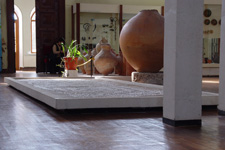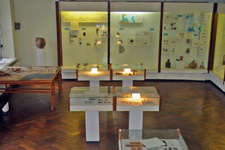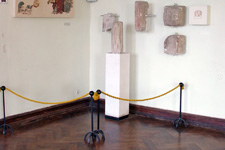|
Showcase XXII
|
The beauty of vessels was increased by green and
brown spots that were applied with brushes and did not coincide with the
ornament. From the twelfth century onwards, the ornamentation of vessels became
very different: there were floral and
geometrical patterns, pictures of animals and monsters, mythological scenes;
many of such designs served as an amulet for their owners.
Different tools were used for making ornaments
including instruments with sharp or dull working edge, combed stamps were
applied to make multi-waved patterns, though brushes were used to paint the
ware. When firing, the artefacts were separated one from another with a special
tripod. These and other tools are presented in the left part of the vitrine.
The vitrine contains multi-coloured vessels with
engraved images of various lattice-works, dragons and riders fighting with
dragons, snakes with birds, and fishes.
To
the left on the bottom of the vitrine, you can see the potter's wheel that was
used for making ceramic ware.
|
|
|
|
|
Museum halls
|
Hall 1

Exhibition sections:
ВЕЛИКОЕ ПЕРЕСЕЛЕНИЕ НАРОДОВ_en; ГОРОДСКОЕ УПРАВЛЕНИЕ_en; Army; Religion; МОНУМЕНТАЛЬНАЯ АРХИТЕКТУРА И ИСКУССТВО_en; ГОРОДСКОЕ СТРОИТЕЛЬСТВО_en; РЕМЕСЛА_en; СЕЛЬСКОЕ ХОЗЯЙСТВО И ПРОМЫСЛЫ_en; | Hall 2

Exhibition sections:
ОБРАБОТКА КОСТИ И ДЕРЕВА_en; ТКАЧЕСТВО И ПРЯДЕНИЕ_en; БЫТ_en; МОНЕТНОЕ ДЕЛО_en; ТОРГОВЛЯ_en; РУССКО-КОРСУНСКИЕ СВЯЗИ_en; | Hall 3

Exhibition sections:
СЕВЕРНОЕ ПРИЧЕРНОМОРЬЕ И ВИЗАНТИЯ В XII – XIII вв._en; |
|
